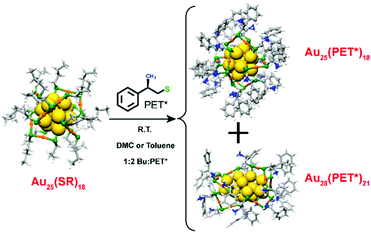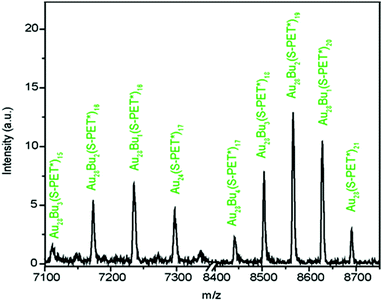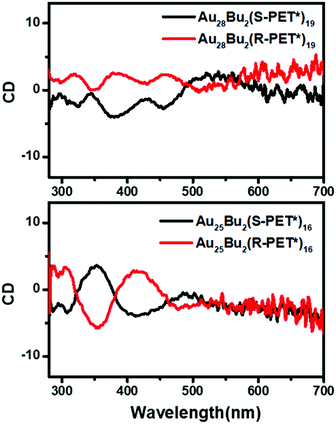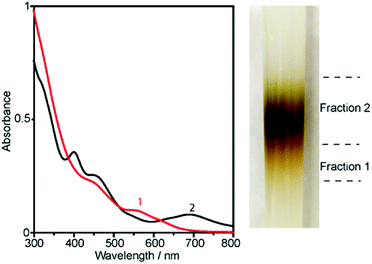 Open Access Article
Open Access ArticleTransformation from [Au25(SCH2CH2CH2CH3)18]0 to Au28(SCH2CH(CH3)Ph)21 gold nanoclusters: gentle conditions is enough†
Yanan
Wang
 ,
Belén
Nieto-Ortega
,
Belén
Nieto-Ortega
 and
Thomas
Bürgi
and
Thomas
Bürgi
 *
*
Département de Chimie Physique, Université de Genève, 30 Quai Ernest-Ansermet, 1211 Genève 4, Switzerland. E-mail: thomas.buergi@unige.ch
First published on 19th November 2019
Abstract
Herein we report the transformation of [Au25(SR)18]0 into Au28(SR)21 induced by ligand exchange reaction. In contrast to other reported cluster transformations, which proceed at elevated temperature and large excess of incoming ligands, the transformation reported here occurs under mild conditions (room temperature, very low thiol excess) with a chiral ligand. A difference of one methyl group between incoming and leaving thiol is sufficient to induce the transformation. To the best of our knowledge the Au28(SR)21 cluster has not been isolated before.
In the last decade, thiolate-protected gold nanoclusters have gained significant attention due to possible applications in sensing, catalysis and molecular electronics to name a few.1,2 Also, the interest has grown because nowadays it is possible to obtain these materials by well-established synthetic methods,3 molecularly pure,4–6 with a precise chemical formula (denoted as Aun(SR)m, in general), which allows one to address fundamental questions concerning matter at the nanoscale. Interestingly, it has been discovered that these materials could also be obtained by the transformation of one structure into another.7,8
In a recent work, Maran et al. reported that Au25(PET)18 (where PET = 2-phenylethylthiolate) is able to slowly react with itself, without any co-reagent, generating Au38(PET)24. The authors propose that the size transformation reaction involves the formation of a precursor complex in which van der Waals interactions between the ligands of the two interacting clusters act as initial driving force.8 However, according to the current literature, the main way to trigger such cluster transformation is by ligand exchange reactions (LERs, here after). LERs is a process that takes advantage of the dynamic nature of the thiol–gold surface9 and in most cases it does not cause any change in size or structure of the cluster, only replacing one capping ligand by another one (the latter in excess in solution).10
LERs induced transformations can be classified into three groups. (I) Transformation between structural isomers without size change. For example, Au28(SR)20 nanocluster reversibly changes its structure upon ligand exchange between R = c-C6H11 and R = Ph-tBu at elevated temperatures (e.g., 80 °C).11 (II) Transformations from a larger to a smaller nanocluster.12–16 For instance, highly stable Au144(SC2H4Ph)60 reacted with thiophenol, HSPh, to form a different 99 atom cluster species Au99(SPh)42. (III) Transformations from a smaller to a larger nanocluster.16–19 An interesting example is the transformation of Au25(PET)18 into Au28(TBBT)20 (where TBBT = 4-tert-butylbenzenethiolate).17 Au25(PET)18 is probably the most studied thiolate-protected nanocluster, due to its prototypical character. At 80 °C and in large excess of TBBT the cluster is transformed into Au28(TBBT)20. It is worth to mention that the resulting Au28(TBBT)20 cluster is chiral, presenting a pair of enantiomers which can be separated by chiral-HPLC.
Cluster transformations induced by LER typically require large excess of incoming ligand, normally more than 100 times compared to the endogenous ligand, and elevated temperatures to proceed.7 This becomes evident from Table S1 (ESI†), which compiles the conditions of the reported cluster transformations. In addition, Jin and coworkers argued that the incoming thiol must be significantly different from the endogenous thiol for the transformation to happen.7,20 Herein we report a cluster transformation that takes place at room temperature in less than a day and mild condition with ratio of incoming to endogenous ligand of 2![[thin space (1/6-em)]](https://www.rsc.org/images/entities/char_2009.gif) :
:![[thin space (1/6-em)]](https://www.rsc.org/images/entities/char_2009.gif) 1. Under these conditions [Au25(SR)18]0 transforms into a larger cluster, Au28(SR)21, by LERs. To our best knowledge, the Au28(SR)21 cluster has not yet been isolated but has been detected previously as [Au28(TBBT)21]3− by mass spectrometry within a mixture of different clusters in a study of seed-mediated growth from Au25 to Au44.21
1. Under these conditions [Au25(SR)18]0 transforms into a larger cluster, Au28(SR)21, by LERs. To our best knowledge, the Au28(SR)21 cluster has not yet been isolated but has been detected previously as [Au28(TBBT)21]3− by mass spectrometry within a mixture of different clusters in a study of seed-mediated growth from Au25 to Au44.21
In our work, PET or butanethiol (abbreviated as SBut) were used as initial ligand for [Au25(SR)18]0, which was synthesized and purified according to reported protocols.22 LERs were performed with a chiral free ligand: R- or S-2-phenylpropane-1-thiol (Scheme 1, abbreviated as R- or S-PPT hereafter, which were synthesized following a published protocol23 with minor modifications). Neither thermal activation nor large excess of the incoming ligand was required to promote the transformation. Interestingly, this transformation was observed when the only difference between the endogenous and the incoming thiol is one additional methyl group, which leads to a chiral centre and which changes the bulkiness and sterics of the thiolate ligand.19 The resulting Au28(SR)21 and [Au25(SR)18]0 clusters were characterized by UV-vis absorption, circular dichroism (CD), NMR, matrix-assisted laser desorption ionization time-of-flight (MALDI-TOF) mass spectrometry and electrospray ionization (ESI) mass spectroscopy (see ESI† for synthesis and characterization details).
 | ||
| Scheme 1 Transformation of [Au25(SR)18]0 cluster to [Au25(PPT)18]0 and Au28(PPT)21. The depicted structure of Au28(PPT)21 is an illustration. The real structure is unknown. | ||
LERs were similarly performed to that described in previous work:24 10 mg of [Au25(SBut)18]0 or [Au25(PET)18]0 cluster (the synthesis and characterizations of these two clusters can be found in Section II, ESI†) were dissolved in 10–15 mL of dichloromethane or toluene solvent together with free chiral ligand (R- or S-PPT). A molar ratio of 1![[thin space (1/6-em)]](https://www.rsc.org/images/entities/char_2009.gif) :
:![[thin space (1/6-em)]](https://www.rsc.org/images/entities/char_2009.gif) 2 regarding the ligand was used. The reaction mixture was slowly stirred for 18 hours at room temperature. All the reaction conditions and UV-vis spectra of the different LERs experiments are given in Section III (ESI†). In the following, we will focus on the reaction carried out with [Au25(SBut)18]0 and S-PPT, although consistent results were obtained with [Au25(SBut)18]0 or [Au25(PET)18]0 and R-PPT. After the LERs, the product was purified by size exclusion chromatography (SEC), and the different fractions analysed by UV-vis measurements. According to the obtained UV-vis curves (Fig. S5, ESI†), gradual change of the spectra was observed. Apart from the spectrum of [Au25(SBut)18]0, which eluted later, a different spectrum was observed for the first fraction, indicating a new species. Note that the new species and the Au25 cluster are not clearly separated in the column (inset Fig. 1). Two representative curves after normalization are depicted in Fig. 1 which illustrate the distinctly different spectra. The absorption spectra in Fig. 1 (fraction 1 and fraction 2) were obtained from an experiment where only the beginning of fraction 1 and the end of fraction 2 were collected (fraction no. 1 and fraction no. 4 from Fig. S5, ESI†), in order to avoid mixing of the two species. The spectrum of fraction 2 is characteristic of [Au25(SBut)18]0. Fraction 1, which elutes first and which therefore corresponds to a larger cluster, shows a different spectrum. Compared to [Au25(SBut)18]0 the peaks at 400 and 690 nm are missing and a new peak appears at 557 nm. The purity of fraction 1 was also investigated by NMR (Fig. S15, ESI†). The missing signal ∼1.40 ppm originating from the –SH group in the cluster spectrum demonstrates the absence of free ligand.
2 regarding the ligand was used. The reaction mixture was slowly stirred for 18 hours at room temperature. All the reaction conditions and UV-vis spectra of the different LERs experiments are given in Section III (ESI†). In the following, we will focus on the reaction carried out with [Au25(SBut)18]0 and S-PPT, although consistent results were obtained with [Au25(SBut)18]0 or [Au25(PET)18]0 and R-PPT. After the LERs, the product was purified by size exclusion chromatography (SEC), and the different fractions analysed by UV-vis measurements. According to the obtained UV-vis curves (Fig. S5, ESI†), gradual change of the spectra was observed. Apart from the spectrum of [Au25(SBut)18]0, which eluted later, a different spectrum was observed for the first fraction, indicating a new species. Note that the new species and the Au25 cluster are not clearly separated in the column (inset Fig. 1). Two representative curves after normalization are depicted in Fig. 1 which illustrate the distinctly different spectra. The absorption spectra in Fig. 1 (fraction 1 and fraction 2) were obtained from an experiment where only the beginning of fraction 1 and the end of fraction 2 were collected (fraction no. 1 and fraction no. 4 from Fig. S5, ESI†), in order to avoid mixing of the two species. The spectrum of fraction 2 is characteristic of [Au25(SBut)18]0. Fraction 1, which elutes first and which therefore corresponds to a larger cluster, shows a different spectrum. Compared to [Au25(SBut)18]0 the peaks at 400 and 690 nm are missing and a new peak appears at 557 nm. The purity of fraction 1 was also investigated by NMR (Fig. S15, ESI†). The missing signal ∼1.40 ppm originating from the –SH group in the cluster spectrum demonstrates the absence of free ligand.
Both fractions were analysed by ESI mass spectroscopy in positive mode. As expected, fraction 2 shows a distribution between 6500–7100 Da (Fig. S16, ESI†) and the most abundance cluster with mass of 6776.58 Da assigned to [Au25(SBut)14(S-PPT)4]0 (theoretical value is 6777.69 Da). Fig. S17 (ESI†) shows the mass spectrum of fraction 1, which has a distribution of clusters reminiscent of the ligand exchange. The most abundant cluster with a mass of m/z = 8255.19 Da is assigned to Au28(SBut)7(S-PPT)14 (theoretical mass 8257.34 Da). Simulated isotopic patterns of the suspected cluster are in excellent agreement with the experimental high resolution ESI spectra, providing further evidence of the new cluster (Fig. S18, ESI†). By running the ligand exchange a second time, after removal of free ligands and Au25, (under the same conditions) the yield of the new species could be increased. The ESI spectrum of fraction 1 of such an experiment is shown in Fig. 2. Again a distribution of Au28(SBut)x(S-PPT)21−x species is observed with a peak at m/z = 8691.0 Da (theoretical value 8692.04 Da) assigned to the completely exchanged species Au28(S-PPT)21. It is worth to mention that a prominent fragment of Au24(S-PPT)17 is also detected at m/z = 7297.4, i.e., after the loss of Au4(S-PPT)4 unit, which is very common in mass spectrometry of thiolate-protected clusters. Due to the overlap of the two cluster fractions on the SEC column, clear peaks of [Au25(SBut)x(S-PPT)18−x]0 are also observed (Fig. S19, ESI†). In order to clarify if this transformation is unique to the neutral [Au25(SR)18]0 cluster, (which is an open shell system) we repeat the LER reaction with the closed shell anionic [Au25(SR)18]− cluster and R-PPT. From the UV-vis (Fig S20, ESI†) and mass spectra (Fig S21, ESI†), no Au28SR21 cluster could be identified, meaning that the title transformation does not occur with the anionic species cluster.
 | ||
| Fig. 2 Electrospray ionization (ESI) mass spectroscopy of the fraction 1 from Fig. 1. | ||
The Au28(S-PPT)21 cluster has similar composition as Au28(TBBT)20 (they differ in one ligand), which has been obtained by LERs induced transformation from [Au25(PET)18]0.17 Comparing the UV-vis spectra of both clusters, it is evident that the UV-vis of Au28(TBBT)20 presents three bands at 365, 480 and 580 nm,17 while the spectrum of Au28(S-PPT)21 shows only two bands at 448 and 557 nm (Fig. 1). Interestingly, the Au28(TBBT)20 cluster undergoes structural change (isomerism) upon LERs with cyclohexanethiol (S-c-C6H11). Note that in the former thiol an aromatic ring is directly connected to the sulphur, which is not the case in the latter.11 The spectrum of Au28(S-c-C6H11)20 presents bands at 460 and 550 nm similar to the spectrum in Fig. 1, however the band at 355 nm of Au28(S-c-C6H11)20 spectrum is missing in Au28(R-PPT)21 as well. Zeta potential measurements of the cluster in toluene revealed a slightly negative value (−7.6 ± 1.2 mV), which may indicate one negative charge anionic cluster with free electron count of 8 (magic numbers).
The experiments described above indicate the coexistence of Au28(S-PPT)21 and [Au25(S-PPT)18]0 clusters after the LER in mild conditions. In addition, the LERs at different ratio of incoming/endogenous thiol as shown in Section III (ESI†), implied that an increase in the chiral ligand gives rise to an increase in the proportion of Au28(R-PPT)21 cluster. Moreover, large amount of the incoming ligand (above 1![[thin space (1/6-em)]](https://www.rsc.org/images/entities/char_2009.gif) :
:![[thin space (1/6-em)]](https://www.rsc.org/images/entities/char_2009.gif) 5 molar ratio) make both clusters unstable and no clear UV-vis features were observed for the resulting solution (Fig. S9, ESI†).
5 molar ratio) make both clusters unstable and no clear UV-vis features were observed for the resulting solution (Fig. S9, ESI†).
CD spectroscopy is a powerful tool, very sensitive to the structure of clusters. Fig. 3 shows the CD spectra of R/S-PPT-substituted Au28(SBut)21 and [Au25(SBut)18]0 clusters. From the distribution of ligands as determined by ESI analysis in Fig. 2 and Fig. S16 (ESI†), an average formula of these two clusters of Au28(SBut)2(PPT)19 and [Au25(SBut)2(PPT)16]0 can be obtained. Intense bands at 305 (positive), 352 (negative), 415 nm (positive) and 480 nm (negative) observed in the CD spectra of [Au25(SBut)2(R-PPT)16]0, as expected [Au25(SBut)2(S-PPT)16]0 showed the opposite signs. This result of [Au25(SBut)2(R-PPT)16]0 is in good agreement with the previous published results by Zhu et al., where the [Au25(R-PPT)18]0 cluster was prepared by direct synthesis.23 Compared with CD spectrum of [Au25(SBut)2(PPT)16]0 the spectrum of Au28(SBut)2(PPT)19 is significantly different, showing three intense bands at 325 nm, 380 nm, 460 nm and a weak one at 530 nm. As expected, the two spectra of Au28(SBut)2(PPT)19 with two enantiomers of the ligand display good mirror image relationship.
 | ||
| Fig. 3 CD spectra of R/S-PPT-substituted Au28(SR)21 (A) and [Au25(SR)18]0 (B) nanoclusters. The average formulations of clusters are calculated by intensity of related ESI spectra. | ||
In order to find out if the core of Au28(PPT)21 is chiral, we performed a LERs in the opposite direction, i.e., the Au28(S-PPT)21 cluster was reacted with an achiral thiol (specifically SBut thiol, 1![[thin space (1/6-em)]](https://www.rsc.org/images/entities/char_2009.gif) :
:![[thin space (1/6-em)]](https://www.rsc.org/images/entities/char_2009.gif) 2 S-PPT
2 S-PPT![[thin space (1/6-em)]](https://www.rsc.org/images/entities/char_2009.gif) :
:![[thin space (1/6-em)]](https://www.rsc.org/images/entities/char_2009.gif) SBut). A CD spectrum was recorded immediately after purification, but no clear CD bands were observed (Fig. S22, ESI†). That means, either the Au28(SR)21 cluster is achiral, or we have a racemic mixture even after LERs. It is worth to mention that after LERs with SBut, the Au28(SR)21 remains stable and no formation of Au25 was observed (Fig. S11, ESI†). Therefore, the new Au28(SR)21 cluster is stable to LERs.
SBut). A CD spectrum was recorded immediately after purification, but no clear CD bands were observed (Fig. S22, ESI†). That means, either the Au28(SR)21 cluster is achiral, or we have a racemic mixture even after LERs. It is worth to mention that after LERs with SBut, the Au28(SR)21 remains stable and no formation of Au25 was observed (Fig. S11, ESI†). Therefore, the new Au28(SR)21 cluster is stable to LERs.
This new product of LERs, Au28(SR)21, is indeed very unexpected, because Au25 has been extensively used for LERs with different kind of ligands in mild-conditions. However, this transformation has not been reported until now. In our opinion, the main reason is that this new cluster is easily fragmenting in MALDI, much more than [Au25(SR)18]0, making the cluster difficult to be detected. In addition, the cluster is a side-product in LERs with SBut or PET ligands. Further when we performed ligand exchange of [Au25(PET)18]0 with SBut or of [Au25(SBut)18]0 with PET, the amount of Au28 that has been obtained was a few % only (Fig. S12 and S13, ESI†). This makes the detection of the cluster difficult.
Clearly, the type of thiol ligand plays a critical role in the transformation of clusters by LERs. Jin et al. proposed that the difference between incoming/endogenous ligand, mainly the difference in bulkiness, and the thermal conditions are the driving forces for cluster transformations by LERs.25 In our case the transformation of [Au25(PET)18]0 into Au28(R-PPT)21 has been observed when the only difference between the two ligands is a methyl group. Moreover, the electronic conjugation and even the thiol structure (primary thiol) is the same and the transformation is still happening in mild conditions. Our work indicates that very small changes (methyl group) of the ligand can be sufficient to drive a cluster transformation at mild conditions. A possible explanation is that the van der Waals interactions between the ligands are significantly altered by the methyl group and that the changed interactions within the ligand shell drive the transformation.
Finally, it is well-known that racemic mixtures often present a larger degree of packing and less steric hindrance than the corresponding pure enantiomers.26 In order to explore if the transformation depends on the enantiopurity of the ligand, we repeated the LERs in the same experimental conditions but with a racemic mixture of PPT, which is commercially available. As shown in Fig. S14 (ESI†), the UV-vis spectrum indicated the existence of Au28(PPT)21 after LERs without any purification. So we can draw the conclusion that for the formation of Au28(PPT)21 an enantiopure ligand is not necessary.
In summary, we report a new transformation of [Au25(SR)18]0 into Au28(SR)21 by LER with a chiral ligand (R- or S-2-phenylpropane-1-thiol) under mild conditions (room temperature, low thiol excess). We believe that the van der Waals interactions within the ligand shell and the “bulkiness” of the methyl are the main factors driving this process. The Au28 cluster is only a minor side-product in LER with SBut or PET ligands. The yield of Au28(SR)21 was affected by ligand ratio, reaction time and ligand structure. Because of the low yield with LERs using ligands like PET and SBut and due to large fragmentation in MALDI, this cluster is generally difficult to detect. An additional methyl group (leading to a chiral centre) of the incoming ligand promotes the formation of Au28(SR)21, and the transformation of the clusters occurs for the racemic mixture of the ligand, which is commercially available. However, the transformation is unique to the neutral Au28(SR)21 cluster and was not observed for the anionic cluster, which is a closed shell system. We believe that the transformation to Au28(SR)21 should be kept in mind when performing ligand exchange reactions on [Au25(SR)18]0.
TB thanks the Swiss National Science Foundation (grant number 200020_172511) and the University of Geneva for financial support. Belén Nieto-Ortega thanks the Marie Skłodowska-Curie Action Postdoctoral fellowship (790715 ChiralComm) and Yanan Wang thanks the China Scholarship Council fellowship (201706450070).
Conflicts of interest
There are no conflicts to declare.Notes and references
- G. Li and R. Jin, Acc. Chem. Res., 2013, 46, 1749–1758 CrossRef CAS PubMed.
- Y. Wang, X.-K. Wan, L. Ren, H. Su, G. Li, S. Malola, S. Lin, Z. Tang, H. Häkkinen, B. K. Teo, Q.-M. Wang and N. Zheng, J. Am. Chem. Soc., 2016, 138, 3278–3281 CrossRef CAS PubMed.
- R. Jin, Nanoscale, 2015, 7, 1549–1565 RSC.
- H. Qian and R. Jin, Nano Lett., 2009, 9, 4083–4087 CrossRef CAS PubMed.
- H. Qian, Y. Zhu and R. Jin, ACS Nano, 2009, 3, 3795–3803 CrossRef CAS PubMed.
- R. Jin, H. Qian, Z. Wu, Y. Zhu, M. Zhu, A. Mohanty and N. Garg, J. Phys. Chem. Lett., 2010, 1, 2903–2910 CrossRef CAS.
- C. Zeng, Y. Chen, A. Das and R. Jin, J. Phys. Chem. Lett., 2015, 6, 2976–2986 CrossRef CAS PubMed.
- T. Dainese, S. Antonello, S. Bogialli, W. Fei, A. Venzo and F. Maran, ACS Nano, 2018, 12, 7057–7066 CrossRef CAS PubMed.
- T. Bürgi, Nanoscale, 2015, 7, 15553–15567 RSC.
- G. H. Woehrle, L. O. Brown and J. E. Hutchison, J. Am. Chem. Soc., 2005, 127, 2172–2183 CrossRef CAS PubMed.
- Y. Chen, C. Liu, Q. Tang, C. Zeng, T. Higaki, A. Das, D.-e. Jiang, N. L. Rosi and R. Jin, J. Am. Chem. Soc., 2016, 138, 1482–1485 CrossRef CAS PubMed.
- P. R. Nimmala and A. Dass, J. Am. Chem. Soc., 2014, 136, 17016–17023 CrossRef CAS PubMed.
- P. R. Nimmala, S. Theivendran, G. Barcaro, L. Sementa, C. Kumara, V. R. Jupally, E. Apra, M. Stener, A. Fortunelli and A. Dass, J. Phys. Chem. Lett., 2015, 6, 2134–2139 CrossRef CAS PubMed.
- C. Zeng, C. Liu, Y. Pei and R. Jin, ACS Nano, 2013, 7, 6138–6145 CrossRef CAS PubMed.
- C. Zeng, C. Liu, Y. Chen, N. L. Rosi and R. Jin, J. Am. Chem. Soc., 2014, 136, 11922–11925 CrossRef CAS PubMed.
- A. Dass, T. C. Jones, S. Theivendran, L. Sementa and A. Fortunelli, J. Phys. Chem. C, 2017, 121, 14914–14919 CrossRef CAS.
- C. Zeng, T. Li, A. Das, N. L. Rosi and R. Jin, J. Am. Chem. Soc., 2013, 135, 10011–10013 CrossRef CAS PubMed.
- Z. Gan, J. Chen, J. Wang, C. Wang, M.-B. Li, C. Yao, S. Zhuang, A. Xu, L. Li and Z. Wu, Nat. Commun., 2017, 8, 14739 CrossRef CAS PubMed.
- M. Rambukwella, N. A. Sakthivel, J. H. Delcamp, L. Sementa, A. Fortunelli and A. Dass, Front. Chem., 2018, 6, 330 CrossRef PubMed.
- A. Das, C. Liu, C. Zeng, G. Li, T. Li, N. L. Rosi and R. Jin, J. Phys. Chem. A, 2014, 118, 8264–8269 CrossRef CAS PubMed.
- Q. Yao, X. Yuan, V. Fung, Y. Yu, D. T. Leong, D.-e. Jiang and J. Xie, Nat. Commun., 2017, 8, 927 CrossRef PubMed.
- Y. Lu, Y. Jiang, X. Gao and W. Chen, Chem. Commun., 2014, 50, 8464–8467 RSC.
- M. Zhu, H. Qian, X. Meng, S. Jin, Z. Wu and R. Jin, Nano Lett., 2011, 11, 3963–3969 CrossRef CAS PubMed.
- G. Salassa, A. Sels, F. Mancin and T. Bürgi, ACS Nano, 2017, 11, 12609–12614 CrossRef CAS PubMed.
- C. Zeng, H. Qian, T. Li, G. Li, N. L. Rosi, B. Yoon, R. N. Barnett, R. L. Whetten, U. Landman and R. Jin, Angew. Chem., Int. Ed., 2012, 51, 13114–13118 CrossRef CAS PubMed.
- R. Hong, J. M. Fernández, H. Nakade, R. Arvizo, T. Emrick and V. M. Rotello, Chem. Commun., 2006, 2347–2349 RSC.
Footnote |
| † Electronic supplementary information (ESI) available: Synthesis and characterization of Au25 and Au28 nanoclusters and details of ligand exchange reactions. See DOI: 10.1039/c9cc08872e |
| This journal is © The Royal Society of Chemistry 2019 |

